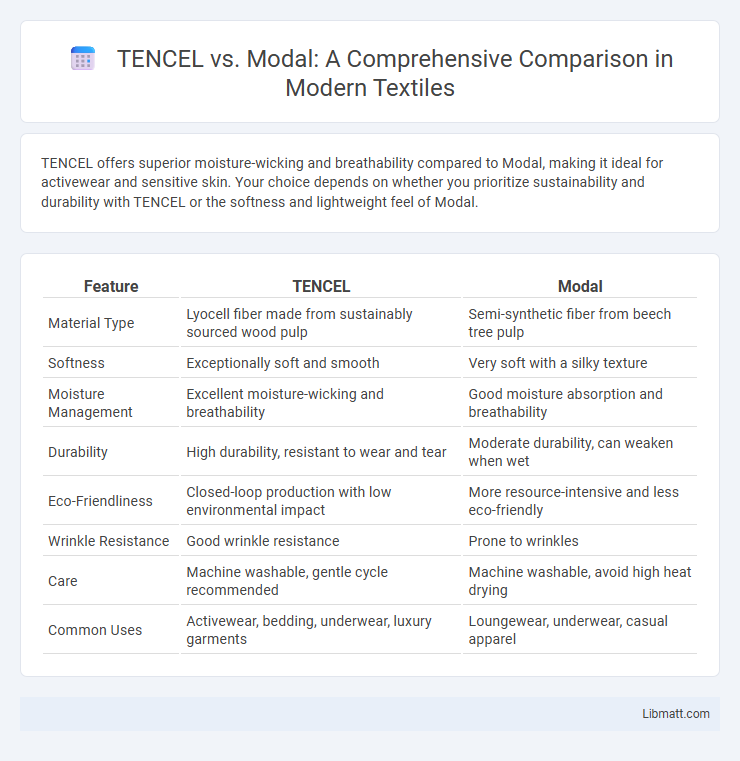TENCEL offers superior moisture-wicking and breathability compared to Modal, making it ideal for activewear and sensitive skin. Your choice depends on whether you prioritize sustainability and durability with TENCEL or the softness and lightweight feel of Modal.
Table of Comparison
| Feature | TENCEL | Modal |
|---|---|---|
| Material Type | Lyocell fiber made from sustainably sourced wood pulp | Semi-synthetic fiber from beech tree pulp |
| Softness | Exceptionally soft and smooth | Very soft with a silky texture |
| Moisture Management | Excellent moisture-wicking and breathability | Good moisture absorption and breathability |
| Durability | High durability, resistant to wear and tear | Moderate durability, can weaken when wet |
| Eco-Friendliness | Closed-loop production with low environmental impact | More resource-intensive and less eco-friendly |
| Wrinkle Resistance | Good wrinkle resistance | Prone to wrinkles |
| Care | Machine washable, gentle cycle recommended | Machine washable, avoid high heat drying |
| Common Uses | Activewear, bedding, underwear, luxury garments | Loungewear, underwear, casual apparel |
Introduction: TENCEL vs Modal
TENCEL and Modal are both semi-synthetic fibers derived from wood pulp, valued for their sustainability and softness in textile production. TENCEL, trademarked by Lenzing, is made from sustainably sourced eucalyptus trees using an eco-friendly closed-loop process, resulting in biodegradable and breathable fabric with excellent moisture management. Modal, also produced by Lenzing but from beech tree pulp, offers a silky texture and high durability, often blended with cotton to enhance fabric strength and comfort.
What is TENCEL?
TENCEL is a branded lyocell fabric made from sustainably sourced wood pulp, primarily eucalyptus trees, produced by Lenzing AG. Known for its exceptional softness, breathability, and moisture-wicking properties, TENCEL is favored in eco-friendly textiles and fashion. The closed-loop production process minimizes environmental impact by recycling water and solvents, enhancing its sustainability credentials compared to conventional fabrics.
What is Modal?
Modal is a type of semi-synthetic fabric made from beech tree pulp, known for its exceptional softness and breathability. It offers excellent moisture-wicking properties, making it ideal for activewear and undergarments. Choosing Modal ensures your clothing feels comfortable against the skin while maintaining durability and resistance to shrinkage.
Raw Materials and Sourcing
TENCEL fibers are derived from sustainably sourced eucalyptus, beech, and spruce wood, processed through a closed-loop system that recycles water and solvents, minimizing environmental impact. Modal fabric originates primarily from beech tree pulp, sourced from sustainably managed forests, but its production involves more chemical use compared to TENCEL. Your choice between TENCEL and Modal should consider the sustainability of raw materials and the eco-friendly nature of their sourcing methods.
Manufacturing Processes Compared
TENCEL fibers are produced through a sustainable closed-loop process using sustainably sourced wood pulp, primarily from eucalyptus trees, which minimizes water and chemical waste. Modal manufacturing also involves cellulose from beech trees but typically requires more water and energy, with less emphasis on eco-friendly recycling methods. Your choice between TENCEL and Modal can impact environmental footprints due to these differences in raw materials and production efficiency.
Environmental Impact: Sustainability and Eco-Friendliness
TENCEL fibers are produced from sustainably sourced wood, using an eco-friendly closed-loop process that recycles water and solvents, significantly reducing environmental pollution compared to traditional fabrics. Modal, while also derived from beech tree pulp, typically involves a more chemically intensive process that can lead to greater water and chemical usage, impacting its overall sustainability. Both fibers are biodegradable, but TENCEL's stricter environmental regulations and lower resource consumption make it a more sustainable and eco-friendly choice for environmentally conscious consumers.
Texture and Comfort Differences
TENCEL fibers offer a smooth, silky texture that feels cool and breathable against the skin, making them ideal for sensitive or warm climates. Modal fabric, derived from beech tree pulp, has a softer, more supple touch with excellent drape and a slightly thicker feel, enhancing comfort in cooler conditions. Both materials provide moisture-wicking properties and breathability, but TENCEL tends to be more eco-friendly due to its sustainably sourced lyocell process.
Durability and Maintenance
TENCEL fibers, made from lyocell, exhibit higher durability and resistance to pilling compared to Modal, which is derived from beech tree pulp but tends to be softer and less robust over time. Both fabrics require gentle maintenance; however, TENCEL's moisture-wicking and temperature-regulating properties contribute to prolonged fabric integrity and color retention after multiple washes. Modal's susceptibility to shrinkage and its delicate fiber structure demand cold water washing and air drying to maintain durability, whereas TENCEL withstands machine washing with less fiber degradation.
Common Uses in Fashion and Textiles
TENCEL fibers are commonly used in high-performance activewear and eco-friendly fashion due to their moisture-wicking and breathable properties. Modal fabrics are popular in casual wear, underwear, and loungewear, prized for their softness and smooth texture. Both materials frequently appear in blended textiles to enhance comfort and durability in garments.
Which Fabric is Right for You?
TENCEL and Modal fabrics both offer exceptional softness and breathability, but TENCEL excels in moisture-wicking and sustainability due to its eco-friendly lyocell fibers, making it ideal for activewear and sensitive skin. Modal, derived from beech trees, provides a silkier feel with excellent drape and durability, perfect for everyday clothing and luxury loungewear. Your choice depends on whether you prioritize eco-conscious performance with TENCEL or a smooth, long-lasting fabric with Modal.
TENCEL vs Modal Infographic

 libmatt.com
libmatt.com